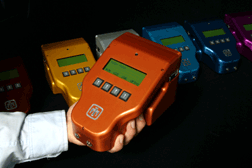The µChemLab™ Bio Detector
Sandia’s chemical analysis system can rapidly detect and analyze toxic agents such as bacteria, viruses, and protozoa
Sandia National Laboratories has developed a compact, hand-held detection system that places the capability of a fully functional chemistry laboratory at the fingertips of a trained field operator. The µChemLabTM was designed, demonstrated, and tested by Sandia researchers over several years. Thetechnology wasinitially developed for homeland security, defense applications, war fighters, and first responders. A variety of applications and near-term commercialization opportunities now exist in markets such as air and water quality, medical diagnostics, biotechnology, and industrial process control.

The µChemLabTM Bio Detector is a portable device for determining the presence of a target analyte and enabling fast microfluidic separations of biological samples with high sensitivity. The device miniaturizes bench-scale analyses using fabricated microchannels in a hand-held, low-power device. Many different separations can be run simultaneously, and identification of the compound of interest is determined from unique retention-time signatures.
Designed for the rapid detection of proteins, the µChemLabTM has been used to identify biotoxins such as ricin, staphylococcal enterotoxin B, and botulinum toxin; its capability has been extended in combination with innovative,automated sample preparation technology to enable the identification of viruses and bacteria. Parallel analysis channels provide highly accurate detection at nanomolar sensitivites with a low false alarm probability.
- Hand-portable
- Low power consumption
- Rapid analyses (5 to 10 minutes)
- Highly accurate detection at nanomolar sensitivities
- Low false alarm rate
- Identification of biotoxins such as ricin, staphylococcal enterotoxin B, and botulinum toxinIdentification of viruses and bacteria Air and water quality testing, medical diagnostics, biotechnology, and industrial process controlFull amenability to DNA-based separations for sizing or fragment detection
- Julia A. Fruetel and Victoria A. VanderNoot. (2011). “CGE for Virus Identification.” Methods in Molecular Biology.
- Victoria A. VanderNoot, Ronald F. Renzi, Bruce P. Mosier, James L. Van de Vreugde, Isaac Shokair, and Brent L. Haroldsen. (2010). “Development of an Integrated Microfluidic Instrument for Unattended Water Monitoring Applications.” Electrophoresis, 31, pp. 2632-2640.
- Julia A. Fruetel, Jason A.A. West, Bert J. Debusschere, Kyle Hukari, Todd W. Lane, Habib N. Najm, Jose Ortega, Ronald F. Renzi, Isaac Shokair, and Victoria A. VanderNoot. (2008). “Rapid Identification of Viruses using Microfluidic Protein Profiling and Bayesian Classification.” Analytical Chemistry, 80, pp. 9005-9012.
- Julia Fruetel, Jason West, Bert Debusschere, Kyle Hukari, Todd Lane, Habib Najm, Jose Ortega, Ronald Renzi, Isaac Shokair and Victoria VanderNoot. (2008). “Identification of Viruses Using Microfluidic Protein Profiling and Bayesian classification.” Analytical Chemistry. 80, pp 9005, 9012. [online]. Available: http://pubs.acs.org/doi/pdfplus/10.1021/ac801342m
- Victoria VanderNoot, Brent Haroldsen, Wayne Einfeld, Yolanda Fintschenko. (2008). “Unattended Water Sensor for Detection of Toxins in Water Systems.” Environmental & Water Resources Institute Currents. 9, pp 6-7. [online]. Available: http://email.asce.org/ewri/UnattendedWaterSensor.html
- Shelly Pizzaro, Pamela Lane, Todd Lane, Evelyn Cruz, Brent Haroldsen, Victoria VanderNoot. (2008, December). “Bacterial characterization Using Protein Profiling in a Microchip Separations Platform.” Electrophoresis. 28(24), pp 4697-4704. [online]. Available: http://onlinelibrary.wiley.com/doi/10.1002/elps.200700005/pdf
- Jeanne Stachowiak, Erin Shugard, Bruce Mosier, Ronald Renzi, Pamela Caton, Scott Ferko, James Van de Vreugde, Daniel Yee, Brent Haroldsen, Victoria VanderNoot. (2007, June). “Autonomous Microfluidic Sample Preparation System for Protein Profile-Based Detection of Aerosolized Bacterial Cells and Spores.” Analytical Chemistry. 79(15), pp. 5763- 5770. [online]. Available: http://pubs.acs.org/doi/pdfplus/10.1021/ac070567z
- Julia Fruetel, Ronald Renzi, Victoria VanderNoot, James Stamps, Brent Horn, Jay A. West, Scott Ferko, Robert Crocker, Christopher Bailey, Don Arnold, Boyd Wiedenman, Wen-Yee Choi, Daniel Yee, Isaac Shokair, Ernest Hasselbrink, Philip Paul, David Rakestraw, Debbie Padgen. (2005, March). “Microchip Separations of Protein Biotoxins Using an Integrated Hand-Held Device.” Electrophoresis. 26(6), pp 1144-1154. [online]. Available: http://onlinelibrary.wiley.com/doi/10.1002/elps.200406194/pdf
- Ronald Renzi, James Stamps, Brent Horn, Scott Ferko, Victoria VanderNoot, Jay A. West, Robert Crocker, Boyd Wiedenman, Daniel Yee, Julia Fruetel. (2005). “Hand-Held Microanalytical Instrument for Chip-Based Electrophoretic Separations of Proteins.” Analytical Chemistry. 77(2), pp 435-441. [online]. Available: http://pubs.acs.org/doi/pdfplus/10.1021/ac049214f
- Julia Fruetel, Brent Horn, Jay A. West, James Stamps, Victoria VanderNoot, Mary Clare Stoddard, Ronald Renzi, Debbie Padgen. (2002). “Engineered improvement of the generation-2 µChemLab biotoxin detector.” µTAS 2002. Y Babu et al. (eds.) Kluwer Academic: Dordrecht. pp. 703-705.
- Ronald Renzi, James Stamps, Robert Crocker, Boyd Wiedenman, Scott Ferko, Brent Horn, Daniel Yee, Victoria VanderNoot, Jay West, Julia Fruetel, Yolanda Fintschenko, Mary Clare Stoddard. (2002). “Engineered improvement of the generation-2 µChemLab biotoxin detector.” µTAS 2002. Y Babu et al. (eds.) Kluwer Academic: Dordrecht. pp. 703-705.
- Julia Fruetel, Ronald Renzi, Robert Crocker, Victoria VanderNoot, James Stamps, Daniel Yee, David Rakestraw, Philip Paul, Don Arnold, Christopher Bailey. (2001). “µChemLab/CB: Parallel Channel Analysis in an Integrated Microchip Device.” 14th International Symposium on Microscale Separations and Analysis. Boston, MA, January 13-18.
- Julia Fruetel, Robert Crocker, Victoria VanderNoot, Scott Ferko, James Stamps, Isaac Shokair, Daniel Yee, Ernest Hasselbrink. (2000). “Development of µChemlab/CB for detection of biotoxins.” Proceedings of the First Joint Detection for Chemical and Biological Defense. pp. 131-139.
| Patent Title | Patent Number | Grant Date |
|---|---|---|
| Modular high voltage power supply for chemical analysis | 7,710,086 | 05/04/2010 |
| Portable apparatus for separating sample and detecting target analytes | 7,452,507 | 11/18/2008 |
| Modular high voltage power supply for chemical analysis | 7,400,119 | 07/15/2008 |
SD# 8412.1; SD# 8427; SD# 8409; SD# 8427.1; SD# 8427.2
Published9/29/2011
Last Updated1/7/2025